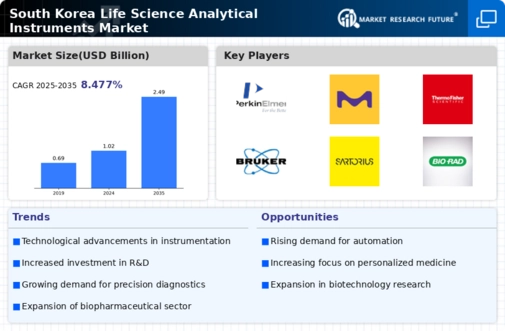The life science-analytical-instruments market in South Korea is characterized by a dynamic competitive landscape, driven by innovation, technological advancements, and increasing demand for precision in research and diagnostics. Major players such as Thermo Fisher Scientific (US), Agilent Technologies (US), and Shimadzu Corporation (JP) are at the forefront, each adopting distinct strategies to enhance their market presence. Thermo Fisher Scientific (US) focuses on expanding its product portfolio through continuous innovation, while Agilent Technologies (US) emphasizes strategic partnerships to bolster its capabilities in genomics and proteomics. Shimadzu Corporation (JP) is leveraging its strong local manufacturing base to optimize supply chains and reduce operational costs, thereby enhancing its competitive edge. Collectively, these strategies contribute to a moderately fragmented market structure, where collaboration and technological differentiation are pivotal for success.
Key business tactics employed by these companies include localizing manufacturing and optimizing supply chains to meet the specific needs of the South Korean market. The competitive structure appears to be moderately fragmented, with several key players vying for market share. This fragmentation allows for a diverse range of products and services, fostering innovation and competition among the leading firms. The influence of these key players is substantial, as they continuously adapt to market demands and regulatory changes, shaping the overall landscape of the industry.
In October 2025, Thermo Fisher Scientific (US) announced the launch of a new line of high-throughput mass spectrometry systems designed to enhance drug discovery processes. This strategic move is likely to position the company as a leader in the pharmaceutical research sector, addressing the growing need for rapid and accurate analytical solutions. The introduction of these advanced systems may significantly improve laboratory efficiency and data accuracy, thereby attracting a broader customer base.
In September 2025, Agilent Technologies (US) entered into a partnership with a leading South Korean university to develop cutting-edge genomic analysis tools. This collaboration is expected to enhance Agilent's research capabilities and expand its footprint in the academic sector, which is increasingly focused on personalized medicine. By aligning with academic institutions, Agilent may gain access to innovative research and development opportunities, further solidifying its competitive position.
In August 2025, Shimadzu Corporation (JP) unveiled a new eco-friendly analytical instrument that utilizes less energy and generates minimal waste. This initiative aligns with the growing emphasis on sustainability within the industry and reflects Shimadzu's commitment to environmental responsibility. By prioritizing sustainable practices, the company may not only comply with regulatory standards but also appeal to environmentally conscious consumers, thereby enhancing its market appeal.
As of November 2025, current competitive trends in the life science-analytical-instruments market include a pronounced shift towards digitalization, sustainability, and the integration of artificial intelligence (AI) in analytical processes. Strategic alliances are increasingly shaping the landscape, enabling companies to pool resources and expertise to drive innovation. Looking ahead, competitive differentiation is likely to evolve, with a greater emphasis on technological advancements and supply chain reliability rather than solely on price. This shift suggests that companies that prioritize innovation and sustainability will be better positioned to thrive in the evolving market.

















Leave a Comment